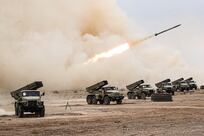I first went to the Arabian Travel Market (ATM) five years ago. As a treat, Nakheel, the developer of the Palm islands, ferried hundreds of exhibitors out to The World archipelago of artificial islands that it was hoping to market to international investors. A few journalists were allowed to tag along in steerage for the lavish reception on the island - one of about 300 then being created about 4km off the coast of Jumeirah.
The venue was Greenland, which was a sort of show island for the development - albeit a warmer, sandier and less polar bear-populated version of the original. Half a decade later, The World looks much as it did then. It turned out that not many of the visiting travel agents were in the market for a US$50 million (Dh183.6m) island as an occasional retreat from their daily grind at Thomas Cook. The trip from the Burj Al Arab to The World was only about 40 minutes on that balmy Monday evening in May. But it took twice as long to return because the boat kept on getting lost among the waterways that separated the various continents and countries.
We may have taken a right down the Suez Canal instead of heading straight for the Cape. Either way, I remember noting it as a potential problem for the future residents of the islands. Just one wrong turn could turn a dispute between neighbours into a geopolitical incident of Lilliputian proportions. Back in 2005, the Arabian Travel Market was more about property than hospitality. The big developers of the emirate occupied stands that towered over those of hotels and tour operators. Giant models of lavish resorts peppered the halls of the exhibition centre where Nakheel was the largest single exhibitor and Dubailand the second-largest.
The fortunes of the emirate's property and tourism industries have always been tightly entwined. The Dubai Holding-owned Dubailand and the Dubai World-owned Nakheel were together given the task of delivering the sort of infrastructure that could secure 15 million tourists by 2015, or more than twice the current number of visitors. Nakheel, through building artificial islands, would deliver hundreds of kilometres of new beachfront for holidaymakers to baste themselves on, while Dubailand would build theme parks on an unprecedented scale while making maximum use of the city's undeveloped desert hinterland.
Development on this scale had never been tried before. Dubailand has long been the very largest of the larger-than-life developments that have come to be associated with the emirate over the last decade. It looked ambitious even at the very height of the economic boom, largely because theme parks require huge centres of population close by to pay for themselves. But such was the frenzy of interest from developers that Dubailand projects were being announced on an almost weekly basis through much of 2005. At one point, there were even two Dubailand developments located next to each other that both included multimillion-dollar replicas of the Taj Mahal.
It would have been great to be a fly on the wall when that little oversight was noticed by one or other of the respective project teams. These days, not many property developers set out their stalls at the ATM, which opened yesterday. Dubailand is still there, exhibiting projects that have become fondly familiar over the years but remain largely concepts. This year the Dubailand stand covers 800 square metres and includes 14 projects.
A few such as MotorCity, Sports City and Dubai Outlet Mall have been either fully or partially completed. But most remain firmly on the drawing board, such as the theme park to be developed by Six Flags, which emerged from US Chapter 11 bankruptcy protection this week, and the Universal Studios park originally announced in 2007 Even more projects are listed on the Dubailand website that are still concepts more than five years after their launch, such as Beauty World, Aqua Dunya and The Great Dubai Wheel.
While the collapse of property prices and the contraction of credit markets has forced the cancellation of hundreds of projects over the past 20 months, the Dubailand website appears somehow frozen in time. The question must be that if many of these schemes failed to attract financial support back in the heady days of 2005 when the region was awash with capital, why are they still being promoted in the radically changed world of today?
Dubailand remains an exciting part of the emirate's rapidly expanding tourism offering even if just a fraction of it is actually built. But the fantasy of its many theme parks needs to be matched with the reality of underlying demand. Visitors to this year's ATM will view some of the same models that have been doing the rounds of international exhibition halls for half a decade. At some stage they need to be built and if that is unlikely to happen any time soon, is there really a case for making any more models?
Otherwise, navigating a path through all of the multibillion-dollar concepts that are still on display will prove to be as challenging as that boat trip to Greenland in 2005. @Email:scronin@thenational.ae





